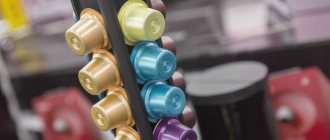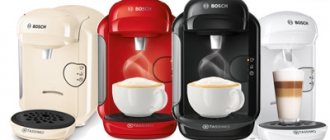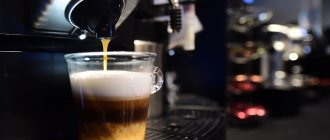The amazing popularity of Nespresso in European and CIS countries gives rise to the question of what is the main advantage of these coffee machines and coffee compared to their competitors. We would like to look into this issue as objectively as possible (we are promoting Lavazza, Nespresso’s main competitor in the capsule segment). They will return to the roots, talk about the Nestle product family and show all the advantages and disadvantages of Nespresso.
How and where did Nespresso come from? What are they?
As you all know, Nesspresso is one of the divisions of Nestle. But at the same time it is a completely independent direction, with its own headquarters in Switzerland, plans and distribution strategy. The first attempts to enter the market were made by Jean-Paul Gaillard in 1986, although according to the company itself, already in 1976, Eric Favre developed a system for capsule coffee preparation that is known to everyone today. At the time of launch, a positioning model was destined - a club system, without membership in which you could not become the owner of a wonderful coffee maker. So Nespresso singled out a market segment in which there were no competitors, which became (as it now turns out) one of the highest-margin areas in the coffee business. It seems to us that the company began with the following judgment: “The client should feel privileged, belonging to a narrow circle of clients, he should be able to feel involved in something
high and inaccessible to other clients,” while pricing is understandable for people with average incomes, which forms the mass market in Europe. From this point on, Nespresso began to pursue its consistent strategy of creating a luxury image in the eyes of the consumer. Below is a graph showing the values and segment that Nespresso has occupied (based on our internal understanding of the situation).
What is the difference between Nespresso and Dolce Gusto
Nespresso is the world's first capsule system, originally from Switzerland, which dates back to the distant 70s of the last century. It remains the market leader today. Dolce Gusto is a younger French brand. Both systems were developed by Nestle and, although the developer company does not produce the machines themselves, capsules for both types of machines are produced by Nestle. Of course, the manufacturer presents the two brands differently on the market. So Nespresso is a more expensive brand in every sense, while Dolce Gusto is positioned as a more affordable system. In the case of Nespresso, the emphasis is on premiumness. This is reflected in the strict, expensive-looking packaging of the capsules, and in the appearance and build quality of the coffee machines themselves. Dolce Gusto is presented to the consumer as a more affordable and, one might even say, youth version of the system. These include more affordable capsules, the range of which encourages buyers to experiment, and a more daring design of the machines themselves. The advertising face of Nespresso is the old heartthrob George Clooney, and Dolce Gusto is advertised by the youth idol musician Will.i.am. Buying Nespresso or Dolce Gusto capsules in Moscow is not difficult, as are the machines themselves for making coffee from capsules. Let’s look at the main differences that will directly affect the choice before purchasing.
Brand Communication
At the beginning of its journey Nespresso
They relied on the club being closed. So the concept of distribution was radically different from the concept of today. The company did not have boutiques and did not communicate with consumers in mass marketing language. As a result, the company's expectations were not met, the brand's popularity did not reach the required levels, and the financial situation pushed top management to large-scale changes. And in 2000, the company's first boutique opened in Paris. Nespresso began to use celebrities in its communication strategy, using their image and positive attitude to create a luxury image in the eyes of the consumer. Nespresso chose the best of the best and attracted George Clooney, Penelope Cruz, Johnny Depp in the image of the Hatter from Alice in Wonderland to their advertising companies.
The main advantages of capsule coffee
Nespresso capsules, like any other coffee, have their advantages and disadvantages. Capsules of this standard are distinguished by excellent taste and other organoleptic qualities and are rightfully considered one of the best in the world.
The main advantages of capsule coffee include:
- Consistently high quality, which is due to the fact that when you buy capsule coffee, you always get equally good coffee in certain constant proportions;
- ease of preparation;
- presence of a large number of tastes.
However, there are some disadvantages.
The lack of versatility of capsule coffee, which greatly complicates the choice for coffee lovers, since the same capsules are not suitable for different coffee machines. The biggest drawback of original Nespresso capsules is the price. Capsulated coffee, if you drink it every day, will cost you 2-3 times more than ground, grain, or, especially, instant coffee. But the quality and pleasure obtained from drinking this coffee completely justify the price. In addition, high-quality analogues come to the rescue. Tags: Nespresso capsules
Nespresso product family
Nestle is achieving success in the luxury segment, but what to do with those who are not ready to overpay for a picture, but are not averse to trying capsule coffee. As part of business diversification and gaining a large market share in the office and home consumption segment, in 2006 Nestle launched another capsule line, now this is a retail line - Dolce Gusto. Unlike Nespresso, the model here is different. The product reaches retailers' shelves, thereby expanding the contact area with the consumer. The customer can buy a coffee machine and coffee in every supermarket. Pricing fits into the model of spontaneous purchasing decisions, because coffee machines are sold almost at cost (~$50). But what can attract attention, and here Nestle also finds a way out. In cooperation with the company Krups, which at that time was already the main manufacturer of coffee machines for Nespresso, they developed daring, hitherto unprecedented coffee machine designs. This move immediately attracts the consumer’s attention to your product. The company is beginning to scale by leaps and bounds. Today, Dolce Gusto is the leader in quantitative terms in the sale of capsules in Europe. And so, Nestle is closing two main consumer segments in Europe. What is the situation with the promising and huge North American market? Having studied the market and tried a strategy that brought success in Europe, Nespresso is faced with the mentality and culture of coffee consumption in America, which is strikingly different from European preferences. Americans mostly consume coffee in large portions, which Nespresso's previously created coffee machines are not designed for. After analyzing the US and Canadian market leader *Keurig, the company realized that their coffee machines and capsule coffee were not able to satisfy the preferences of American customers. Coffee machines are good at preparing a short drink of 30-60 ml, with a rich and dense body in the allotted 20-30 seconds. When I tried to prepare a drink of 200-300 ml of coffee, the coffee turned out hollow, unsaturated, and most importantly, it took more than 2 minutes. So the leader of the luxury segment is thinking about adapting to local peculiarities and already in 2014 they launched the Nespresso VertuoLine system. This is a line of new coffee machines and capsules with a large volume of coffee for comfortable and high-quality preparation of long drinks. Let us remind you that standard Nespresso capsules contain from 5 to 5.5 g of coffee. *Digression:
Keurig was founded in 1998 and is the North American market leader in the OCS (office coffee machines) and home consumption segment. More than 3,000,000 coffee machines sold. The company patented a closed K-cup system, the main difference of which was a large amount of coffee (from 12 to 16 g), coarse grinding and the ability to quickly prepare long drinks.
Competition as an “incentive to keep yourself on your toes”
Coffee capsules became increasingly popular; by 2010, their share of ground coffee sales was already 30%. And it is quite natural that one after another companies arose, claiming a part of this share. The first serious competitor of Nespresso SA was its former head Jean-Paul Gaillard, who by that time had already created his own company producing biodegradable coffee capsules, fully compatible with Nespresso coffee machines.
The stream of competitors does not dry up, the staff of lawyers defending the interests of Nestlé in the courts is growing, and meanwhile marketers are thinking up new advertising moves. At their suggestion, George Clooney became the face of the brand, who, according to British media, received $45 million for the advertising campaign. But even here there was a scandal: an advertising video in which a piano falls on a Hollywood star, and the Apostle Peter gives him back his life for a Nespreso coffee machine with capsules, outraged the management of Lavazza. The Italians called the video an attempt at plagiarism, comparing it with their own “Lavazza,” heaven in a coffee cup,” the main character of which was also the Apostle Peter.
According to Euromonitor International, sales of capsule coffee are growing faster than the market is developing: sales of coffee capsules have tripled since 2010, but the market has increased by only a third. And the number of manufacturers of everyone’s favorite drink is also growing - in 2021 there were 135 of them, and 55 of them have capsules suitable for Nespresso coffee machines. But Nestlé managing director Ulf Schneider, in his interview with the New York Times, commented on this situation with irony - he called competitors “an incentive to maintain tone.”
Nestlé Nespresso SA was and remains a pioneer in the portioned coffee market, it is focused on the premium segment and remains a trendsetter in the field of capsule coffee. The company has 9.5 thousand employees, its products are presented in 63 countries, where there are 340 exclusive boutiques.
Advantages and disadvantages of Nespresso.
In this section we will describe (we want to emphasize - in our subjective opinion) the advantages and disadvantages of the Nespresso system in the realities of the Ukrainian and CIS markets.
Advantages
- We consider the main advantage to be the brand’s image. After all, it’s not in vain that Nespresso pours hundreds of millions into advertising campaigns, so that even the Ukrainian consumer, without having an official representative office in the country, knows the brand, and most importantly, strives to become the owner of coffee equipment and accessories.
- Next, we still want to note the smart design, functionality and range of coffee machines. It is clear that there is no need to compare them with Lavazza Classy range models, but still the guys know a lot about engineering developments.
- If there were Nespresso boutiques in Ukraine, we would, of course, pay attention to this. After all, the atmosphere that reigns in an expensive and beautiful store makes millions of people visit the offline store and stand in an electronic queue to buy coffee machines, accessories and Nespresso coffee capsules.
You can BUY NESPRESSO COFFEE MACHINES AND COFFEE in our online store
As for the shortcomings.
Adherents of the brand will most likely be skeptical))), because we, the authors of this article, popularize and promote brands and services that fiercely compete with Nespresso in Europe - Massimo, Lavazza, illy, Kimbo. But we will still try to be as objective as possible.
- We consider the most important thing to be the amount of coffee in the capsule. A Nespresso capsule contains 5.5 grams of product (for example, Lavazza contains 8.5 g). This has a very strong effect when preparing drinks with a volume of over 50 ml. In such cases, coffee machines produce unsaturated coffee with a loose body.
- Possibility of preparing long drinks with coffee machines. If you drink espresso, everything is fine, but if you still want a larger drink, you will have difficulties. The coffee machine is adapted for preparing a short drink. It presses out a large amount of water for an extremely long time, which in turn leads to the effect of burning the coffee (when the coffee releases a much larger amount of caffeine than necessary and chemicals that form a bitter aftertaste and completely kill the delicate aroma of the drink). In simple terms, use if you only drink espresso.
- High price of capsules. It’s unlikely to be found cheaper than 15 UAH per capsule. Although we, in comparison, wonder why? Lavazza, a world-famous brand with a coffee history of more than 120 years, with technology and culture honed over centuries, sells 8.5 g coffee capsules (Nespresso - 5.5) for half the price.
- If we talk about Ukraine, this is, of course, the lack of official representation. This does not make it possible to buy a product of guaranteed quality and repair the coffee machine in case of breakdown.
- In addition to the expensive price of capsules, you need to buy a coffee machine. Many companies, including Lavazza, provide these coffee machines for free use, provide regular service, exchange them for a new model when they become available, and deliver free coffee.
As for the conclusions. There won't be any)). After reading it, each one will have their own personality. We are glad that you and other readers are looking for information about coffee, drawing it from a variety of sources, trying to understand all the secrets of this wonderful drink and learn more about how to prepare it. This suggests that the level of coffee consumption culture in our country is growing, there is progress, which means we are all on the right path. If, after reading this article, you are deciding whether to give preference to the capsule option for making coffee. The answer is unequivocal - YES. Which brand or company to choose is all very subjective here. Try coffee, test coffee machines and make the right choice. Of course, we recommend that all capsule coffee connoisseurs familiarize themselves with the services of our company Coffice. We have been engaged in this area for more than 7 years, more than 6,000 satisfied customers throughout Ukraine, coffee machines that we provide exclusively for free use and the largest range of capsule coffee brands Massimo, Lavazza, illy, Kimbo will satisfy the desires of the most skilled coffee lovers.
Types and features of capsules for Nespresso
What are capsules for a coffee machine? Each capsule, made of aluminum or food-grade plastic, contains approximately 5-7 grams of coffee, which is the gold standard for those who understand coffee. It is worth noting that more and more manufacturers are appearing on the Russian market offering high-quality analogue capsules of the Nespresso standard. The buyer can easily choose from dozens of types and tastes.
There are many analogues in our country, and buyers are increasingly preferring more affordable options. This is due not only to the lower price, but also to the ever-increasing quality of such capsules. All Nespresso standard capsules differ from each other in various parameters, such as:
- Country of origin of raw materials. The most commonly used coffee is from Brazil, Colombia, Central and South America, Costa Rica and other regions.
- Roasting degree. Roasting can be dark, medium or light.
- Intensity. There are high, medium and light.
- Type of coffee. Arabica or robusta from different parts of the world may be present here.
- Taste shades. Capsules can contain coffee with light shades of cocoa, chocolate, vanilla, floral bouquet, caramel, wood, cereal, fruit and many other options.
It is also worth noting that the line of analogues for Nespresso machines also includes a decaffeinated blend, that is, capsules that do not contain caffeine. These capsules have also become very popular today, and many gourmets claim that the taste and aroma of decaffeinated capsules is very pleasant and is not inferior in quality to natural coffee drinks.
Caffeine content in Nespresso capsules
The key elements of coffee intensity are the location of cultivation, blend and degree of roast; caffeine does not affect this indicator in any way. At the same time, many people are interested in its content in one or another type of drink (the calculation is taken for one serving):
- Nespresso Intenso – characterized by a high percentage of caffeine, approximately 120 mg.
- Nespresso Ristretto – 60-80 mg.
- Nespresso Lungo – 60-80 mg.
- Nespresso Espresso – 50-80 mg.
- Nespresso Decaffeinato - has the lowest indicator, only 2-3 mg.
It is important to note that Nespresso capsule coffee retains the full range of characteristics inherent in freshly ground coffee, and thanks to the variety of types, any coffee lover will be able to satisfy his taste preferences.











